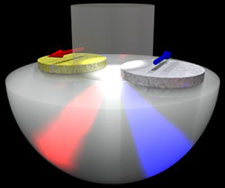
Subwavelength Antenna Separates Colors of Light
A nanoantenna smaller than the wavelength of light has been built that can direct red and blue colors in opposite directions. The finding could lead to optical nanosensors that can detect very low concentrations of gases or biomolecules.
A structure that is smaller than the wavelength of visible light (390-770 nm) shouldn’t really be able to scatter light, but that is exactly what the new nanoantenna does. The researchers, from Chalmers University, found that the trick is to build an antenna with an asymmetric material composition, creating optical phase shifts.
The antenna consists of two nanoparticles — one of silver and one of gold — about 20 nm apart on a glass surface.

Because the gold and silver nanoparticles have differing optical properties, the nanoantenna acts as a router for red and blue light. (Image: Timur Shegai)
“The explanation for this exotic phenomenon is optical phase shifts,” said Chalmers researcher Timur Shegai. “The reason is that nanoparticles of gold and silver have different optical properties, in particular different plasmon resonances. Plasmon resonance means that the free electrons of the nanoparticles oscillate strongly in pace with the frequency of the light, which in turn affects the light propagation even though the antenna is so small.”
Controlling light by using asymmetric material composition — such as silver and gold — is a completely new method. The researchers have shown that the antennas can be fabricated densely over large areas using cheap colloidal lithography.
The rapidly growing research field of nanoplasmonics, which concerns controlling how visible light behaves at the nanoscale using a variety of metal nanostructures, can be applied in a variety of areas, said Mikael Käll, professor in the research group at Chalmers.
“One example is optical sensors, where you can use plasmons to build sensors which are so sensitive that they can detect much lower concentrations of toxins or signalling substances than is possible today,” Käll said. “This may involve the detection of single molecules in a sample, for example, to diagnose diseases at an early stage, which facilitates quick initiation of treatment.”
The research was published in the online journal Nature Communications.
For more information, visit: www.chalmers.se
Published: September 2011